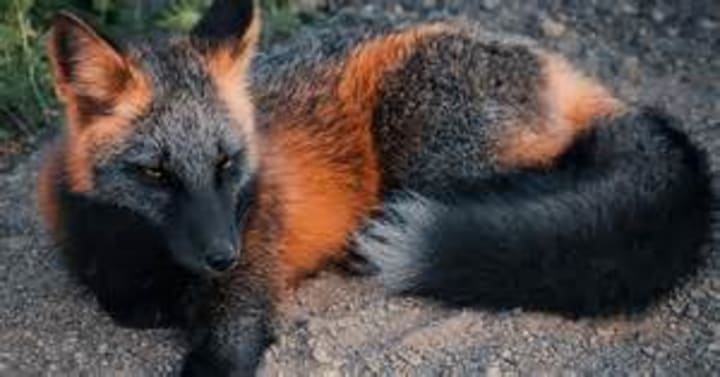5 rarest animal in world
unseen animals

1.,Melanistic fox:

A melanistic fox, also known as a black fox, is a genetic variation of the red fox (Vulpes vulpes) that occurs due to a mutation in the gene that controls fur color. Melanistic foxes have black or dark brown fur, which is caused by an excess of melanin, the pigment that gives color to skin, hair, and fur.
While most red foxes have a reddish-orange coat with white underparts, black foxes have black or dark brown fur all over their bodies, including their tails, legs, and underparts. Some melanistic foxes may have white or silver-tipped fur on their tails, giving them a unique appearance.
Melanistic foxes are relatively rare and are more commonly found in some regions than others. For example, they are more common in certain parts of North America, Europe, and Asia, but they are much less common in other areas.
Despite their unique appearance, melanistic foxes are not a separate species from the red fox. They share the same physical characteristics, behaviors, and habitat requirements as red foxes, and they are able to interbreed with red foxes to produce offspring with varying coat colors.
The black coloration of melanistic foxes can be advantageous in certain environments, such as in forested areas with dark undergrowth or in areas with heavy snow cover, where the black color can provide camouflage. However, in other environments, such as open grasslands, the black coloration may make them more visible and easier for predators to spot.
Overall, melanistic foxes are a fascinating example of genetic variation within a species and offer a unique and striking appearance in the wild.
2.,Pink katydid:

A pink katydid is a rare genetic variation of the common katydid, a type of large, green, leaf-eating insect that belongs to the family Tettigoniidae. Pink katydids are also known as "rosy maple moths" due to their bright pink coloration and their similarity in appearance to moths.
The pink coloration of these insects is the result of a genetic mutation that affects the production of pigments, causing them to lack the green coloration of normal katydids. Instead, they appear pink, red, or even purple due to the presence of red pigments in their wings and bodies.
Pink katydids are extremely rare, and only a small percentage of katydids are born with this coloration. Their bright coloration, combined with their large size and distinctive shape, make them easy to spot in their natural habitat, which is typically wooded areas and gardens.
Pink katydids are primarily nocturnal insects, and they are active during the warm summer months when they mate and feed on the leaves of trees and other plants. They use their strong jaws to chew through the tough leaves and stems of plants, and they are often considered pests by farmers and gardeners.
Despite their unusual coloration, pink katydids are not considered a separate species from the common katydid. They share the same physical characteristics and behaviors as green katydids, and they are able to mate with them to produce offspring with varying colorations.
Overall, pink katydids are a fascinating example of genetic variation in the animal kingdom. Their unique coloration makes them a rare and sought-after find for insect enthusiasts, and they offer a beautiful and striking addition to the natural world.
2.,Chinese white dolphin:

The Chinese white dolphin (Sousa chinensis), also known as the Indo-Pacific humpback dolphin, is a species of dolphin that inhabits the waters of the South China Sea, including the Pearl River Delta in China. The species is notable for its distinctive hump, which is formed by a flexible ridge of connective tissue that runs along its back. The Chinese white dolphin is considered a vulnerable species due to habitat loss, pollution, and hunting.
Appearance and Behavior:
The Chinese white dolphin has a pink or grayish-white coloration, which is more pronounced in adults than in juveniles. It can grow up to 2.5 meters in length and weigh up to 300 kilograms. The species is known for its playful behavior, which includes leaping out of the water, tail-slapping, and interacting with boats.
Habitat and Range:
The Chinese white dolphin inhabits shallow coastal waters and estuaries, including the Pearl River Delta, the waters around Hong Kong, and other areas of the South China Sea. The species is a strong swimmer and can move between different areas of its range to find suitable habitat and prey.
Threats and Conservation:
The Chinese white dolphin is considered a vulnerable species due to a number of threats, including habitat loss, pollution, and hunting. The development of coastal areas and the construction of large infrastructure projects, such as the Hong Kong-Zhuhai-Macau Bridge, have led to habitat destruction and disruption of the species' natural behaviors. Pollution from industrial and agricultural runoff and other sources has also led to health problems for the species, including skin lesions, respiratory issues, and reproductive problems. Finally, hunting for meat and oil was historically a significant threat to the species, although this practice has declined in recent years due to legal protections and conservation efforts.
Conservation efforts for the Chinese white dolphin include protected areas, such as the Hong Kong Dolphin Conservation Society and the Pearl River Estuary Chinese White Dolphin National Nature Reserve, as well as education and outreach programs aimed at raising awareness of the species and its habitat requirements. Additionally, the Chinese government has implemented laws and regulations aimed at protecting the species, although enforcement of these laws remains a challenge.
3.,Bicolor cardinal:

Pyrrhuloxia:
The Pyrrhuloxia (Cardinalis sinuatus) is a species of cardinal that is found in the southwestern United States and parts of Mexico. It has a similar shape to the Northern Cardinal, but with a more muted coloration. The males have a distinctive bicolor pattern with a gray head and back, a red crest and wings, and a gray and red bill. The females have a similar coloration to the males, but with more muted colors and a more distinct pattern of stripes and spots on their feathers.
Behavior and Habitat:
Both the Northern Cardinal and Pyrrhuloxia are non-migratory birds that inhabit woodlands, brushy areas, and suburban gardens. They are omnivorous, feeding on a variety of seeds, fruits, insects, and other small animals.
Conservation Status:
The Northern Cardinal is a common species throughout much of its range, and is not considered to be threatened. The Pyrrhuloxia, however, is listed as a species of least concern, but its population is declining due to habitat loss and other threats. Conservation efforts for the Pyrrhuloxia include the protection of its habitat and the establishment of conservation areas to help preserve the species.
Overall, both the Northern Cardinal and Pyrrhuloxia are beautiful and distinctive species of bird that are beloved by birdwatchers and nature enthusiasts alike.
4.,chemeric cat:

A chimeric cat is a rare genetic phenomenon in which a cat's cells contain two distinct sets of DNA, resulting in a unique and striking physical appearance. Chimerism occurs when two fertilized eggs fuse together in the womb, resulting in a single individual with two different sets of cells and, therefore, two different sets of genes.
Appearance:
Chimeric cats have a distinctively patchy, mottled appearance, with different fur colors or patterns on different parts of their body. This occurs because each set of cells contains different genetic information, resulting in different pigmentation patterns. In some cases, chimeric cats may have two different colored eyes, or different colored fur on different parts of their body.
Behavior:
Chimeric cats exhibit the same behavior as other cats, and their physical appearance does not typically affect their behavior or temperament. They are playful, curious, and affectionate, and make loving pets.
Habitat:
Chimeric cats are not a separate species or breed of cat, but rather a rare genetic variation that can occur in any breed of cat. They can be found in households and animal shelters around the world, but due to their rarity, they are not commonly seen.
Conservation Status:
Chimeric cats are not considered to be a threatened or endangered species, as they are not a distinct species or breed of cat. However, their unique appearance makes them highly sought after by cat enthusiasts and collectors, which can contribute to the demand for breeding programs and the exploitation of animals for aesthetic purposes.
In conclusion, chimeric cats are a fascinating and unique genetic phenomenon that results in a striking and beautiful appearance. They are rare, but can be found in households and animal shelters around the world, and make loving and affectionate pets. However, it is important to remember that they are not a separate species or breed of cat, and should not be exploited for their unique appearance.
5., Harpy eagle:

The harpy eagle (Harpia harpyja) is a large and powerful bird of prey found in the tropical rainforests of Central and South America. It is considered to be one of the most impressive and majestic raptors in the world.
Appearance:
The harpy eagle is one of the largest eagles in the world, with a wingspan of up to 7 feet (2.1 meters) and a weight of up to 20 pounds (9 kilograms). It has a distinctive appearance, with a bold and powerful body, a large head, and a prominent black crest on its head. Its feathers are primarily gray on the upperparts and white on the underparts, with black feathers on the wings and tail. The harpy eagle also has strong and curved talons, which can be up to 5 inches (13 centimeters) long.
Behavior:
The harpy eagle is a formidable predator, feeding primarily on tree-dwelling mammals such as sloths, monkeys, and tree porcupines. It is also known to prey on birds, including macaws and toucans. The harpy eagle hunts by perching on a high vantage point, such as a tall tree, and scanning the surrounding area for prey. It then swoops down and captures its prey with its powerful talons.
Habitat:
The harpy eagle is found in the tropical rainforests of Central and South America, from southern Mexico to northern Argentina. It prefers to live in undisturbed, mature forests, and requires large areas of uninterrupted forest to thrive.
Conservation Status:
The harpy eagle is considered to be Near Threatened by the International Union for Conservation of Nature (IUCN) due to habitat loss and hunting. The species is particularly vulnerable to deforestation, as it requires large areas of uninterrupted forest to survive. Conservation efforts are focused on protecting the harpy eagle's habitat, as well as raising awareness about the importance of this magnificent bird and the need to protect it and its environment.
In conclusion, the harpy eagle is a remarkable and impressive bird of prey, known for its power and majesty. While it faces threats from habitat loss and hunting, conservation efforts are underway to protect this species and ensure its survival for future generations.






Comments
There are no comments for this story
Be the first to respond and start the conversation.